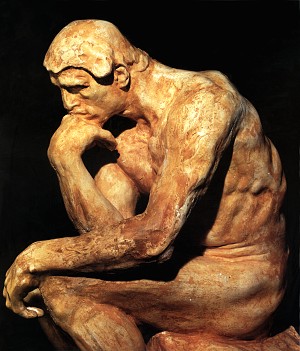|
4. THE PLASTERS WOULD BE TOO DAMAGED FOR PUBLIC EXHIBITION
(1)
Il s'agit là de plâtres de
fonderie usés, enduits d'agents de démoulage qui les amollissent encore
plus.
(….) et qu'à partir de plâtres usés, on ne peut obtenir que des
bronzes de piètre qualité.
[From the Musée Rodin press
release]
USED FOUNDRY PLASTERS AS ESSENTIAL ELEMENT OF THE
TORONTO EXHIBITION
This is a point also echoed by the press, and so we find
these plasters variously called "abraded", "lacking
detail", "worn off", "blunted", "used",
"ruined", "spoiled", "discolored",
"scratched", "dinged", "softened",
"disfigured", "swollen", even "monstrous":
In plaster cast after plaster cast, the forms are
blunted and abraded, sometimes as if dipped in a coating which has
congealed over their surfaces, leaving the shapes generalized -- which
indeed may be the case, depending on what, precisely, the casts were made
for. Some of them are scratched and dinged or badly softened. In many
instances, they are coated with sepia or caramel-coloured amber staining,
presumably the residue of the casting process. Like elegant courtesans
surprised in their shopworn housecoats, a number of them have a
morning-after feel, striking the viewer as awkwardly déshabillé.
Nothing is learned by looking at these plasters about the nature of
Rodin's gift; in fact, his gift has arguably been obscured. All one can
see is the purported physical evidence of standard 19th-century foundry
casting techniques, hardly the stuff that epiphanies are made of. (...)
From: Rodin – Truly A Bust, by Sarah Milroy, Toronto
Globe, 22 Sept. 2001
With every other artist and every other exhibition goal,
this kind of critique would kill the show. Imagine an exhibition with a
damaged Barnett Newman, Picasso, Malevich or Rembrandt painting (works of
these four artists were wilfully damaged in Amsterdam since 1986). In the
case of the R.O.M. exhibition, the problem is a bit more complex again.
First of all, the MacLaren and R.O.M. have explicitly
announced an exhibition educating the public on the casting process.
Already the title "From Plaster to Bronze" indicates clearly
enough that foundry plasters must make up the bulk of the show. If
the exhibition concept is to have any validity at all, of course, these
plaster must be used items, showing visible traces of the casting
process - like the medium sized Thinker plaster displayed in the first
room, stained with orange rust resin. To complain about such traces means
to question the whole exhibition concept, that claims to "go behind
the scenes":
|
|
Foundry plasters are the last artifacts in the process
of making bronzes and often show evidence of their role in this muscular,
earthy process in interesting ways. You can like them or hate them for
that.
The exhibition also includes studio plasters, bronzes
authorized by the Musée Rodin, and bronzes cast from these foundry
plasters in 2000 for educational purposes.
The exhibition explains how sculpture moves from clay to plaster to bronze
using these examples, and places Rodin in the context of Western art.
Going behind the scenes like this, and employing
artifacts usually consigned to the warehouse, can threaten the status quo,
offend academic taste and lead to simple confusion. Obviously.
[From: Letter from William Thorsell, Director R.O.M., to Toronto Globe, 12
Nov. 2001] |

Thinker, plaster, medium size, MacLaren collection.
Photo: Mario Carrieri for GME. Click image to enlarge.
|